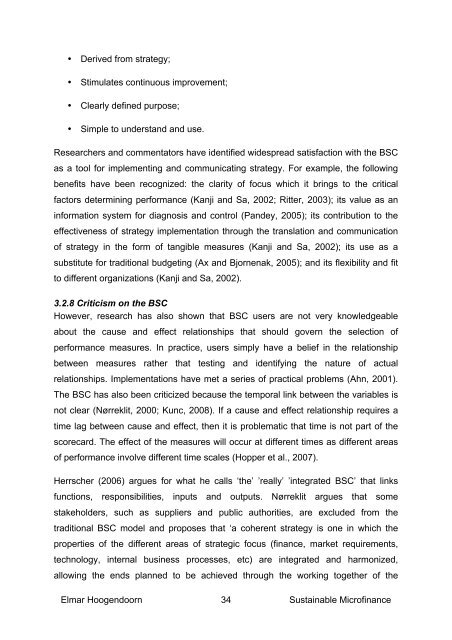Sustainable Microfinance - Balanced Scorecard's added value for ...
Sustainable Microfinance - Balanced Scorecard's added value for ...
Sustainable Microfinance - Balanced Scorecard's added value for ...
You also want an ePaper? Increase the reach of your titles
YUMPU automatically turns print PDFs into web optimized ePapers that Google loves.
• Derived from strategy;<br />
• Stimulates continuous improvement;<br />
• Clearly defined purpose;<br />
• Simple to understand and use.<br />
Researchers and commentators have identified widespread satisfaction with the BSC<br />
as a tool <strong>for</strong> implementing and communicating strategy. For example, the following<br />
benefits have been recognized: the clarity of focus which it brings to the critical<br />
factors determining per<strong>for</strong>mance (Kanji and Sa, 2002; Ritter, 2003); its <strong>value</strong> as an<br />
in<strong>for</strong>mation system <strong>for</strong> diagnosis and control (Pandey, 2005); its contribution to the<br />
effectiveness of strategy implementation through the translation and communication<br />
of strategy in the <strong>for</strong>m of tangible measures (Kanji and Sa, 2002); its use as a<br />
substitute <strong>for</strong> traditional budgeting (Ax and Bjornenak, 2005); and its flexibility and fit<br />
to different organizations (Kanji and Sa, 2002).<br />
3.2.8 Criticism on the BSC<br />
However, research has also shown that BSC users are not very knowledgeable<br />
about the cause and effect relationships that should govern the selection of<br />
per<strong>for</strong>mance measures. In practice, users simply have a belief in the relationship<br />
between measures rather that testing and identifying the nature of actual<br />
relationships. Implementations have met a series of practical problems (Ahn, 2001).<br />
The BSC has also been criticized because the temporal link between the variables is<br />
not clear (Nørreklit, 2000; Kunc, 2008). If a cause and effect relationship requires a<br />
time lag between cause and effect, then it is problematic that time is not part of the<br />
scorecard. The effect of the measures will occur at different times as different areas<br />
of per<strong>for</strong>mance involve different time scales (Hopper et al., 2007).<br />
Herrscher (2006) argues <strong>for</strong> what he calls ‘the’ ’really’ ’integrated BSC’ that links<br />
functions, responsibilities, inputs and outputs. Nørreklit argues that some<br />
stakeholders, such as suppliers and public authorities, are excluded from the<br />
traditional BSC model and proposes that ‘a coherent strategy is one in which the<br />
properties of the different areas of strategic focus (finance, market requirements,<br />
technology, internal business processes, etc) are integrated and harmonized,<br />
allowing the ends planned to be achieved through the working together of the<br />
Elmar Hoogendoorn 34<br />
<strong>Sustainable</strong> <strong>Microfinance</strong>
















![Joint Report on Social Protection and Social Inclusion [2005]](https://img.yumpu.com/19580638/1/190x132/joint-report-on-social-protection-and-social-inclusion-2005.jpg?quality=85)
